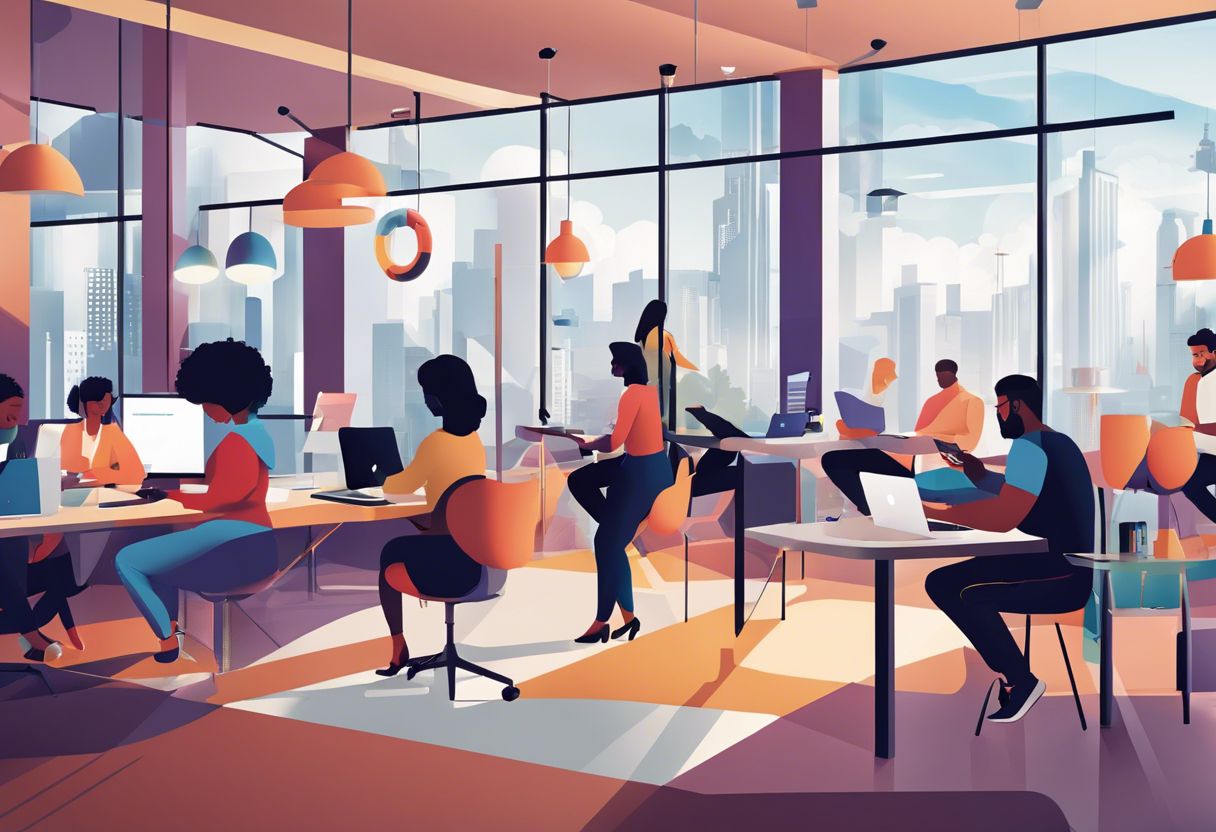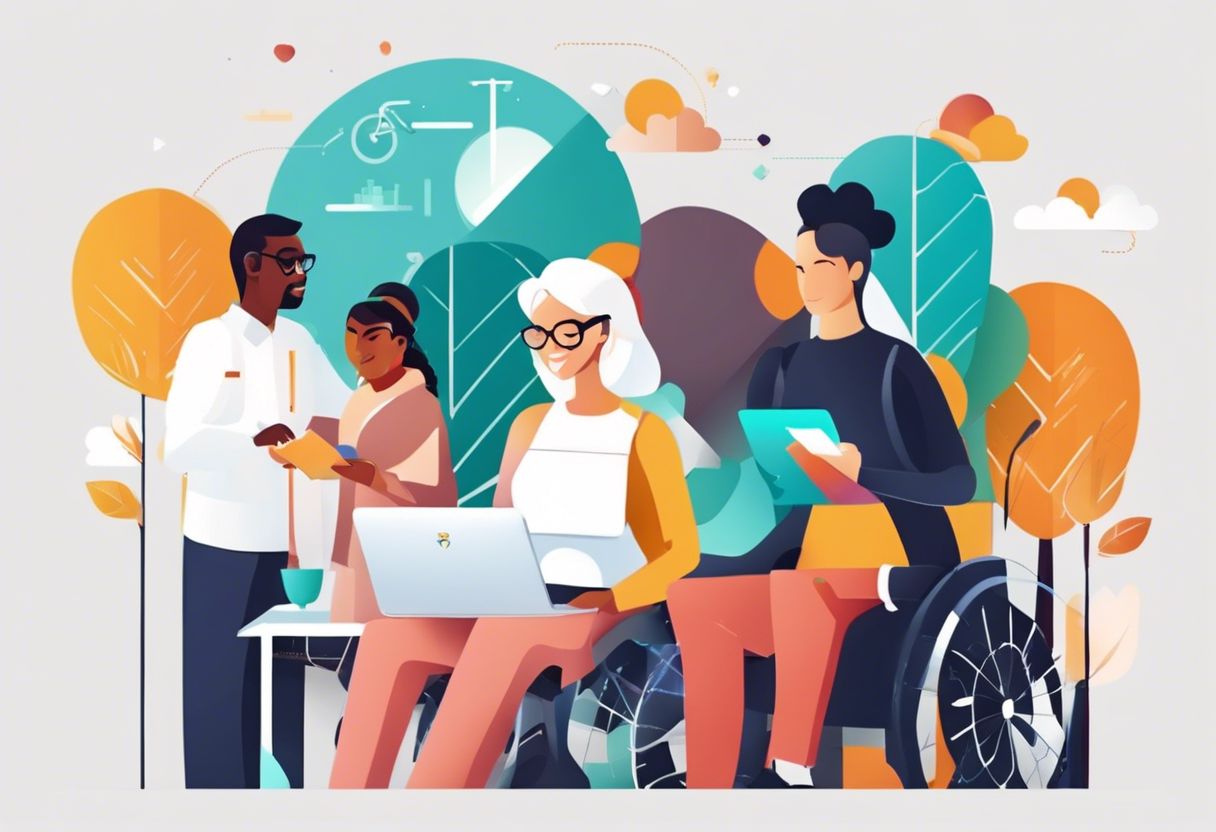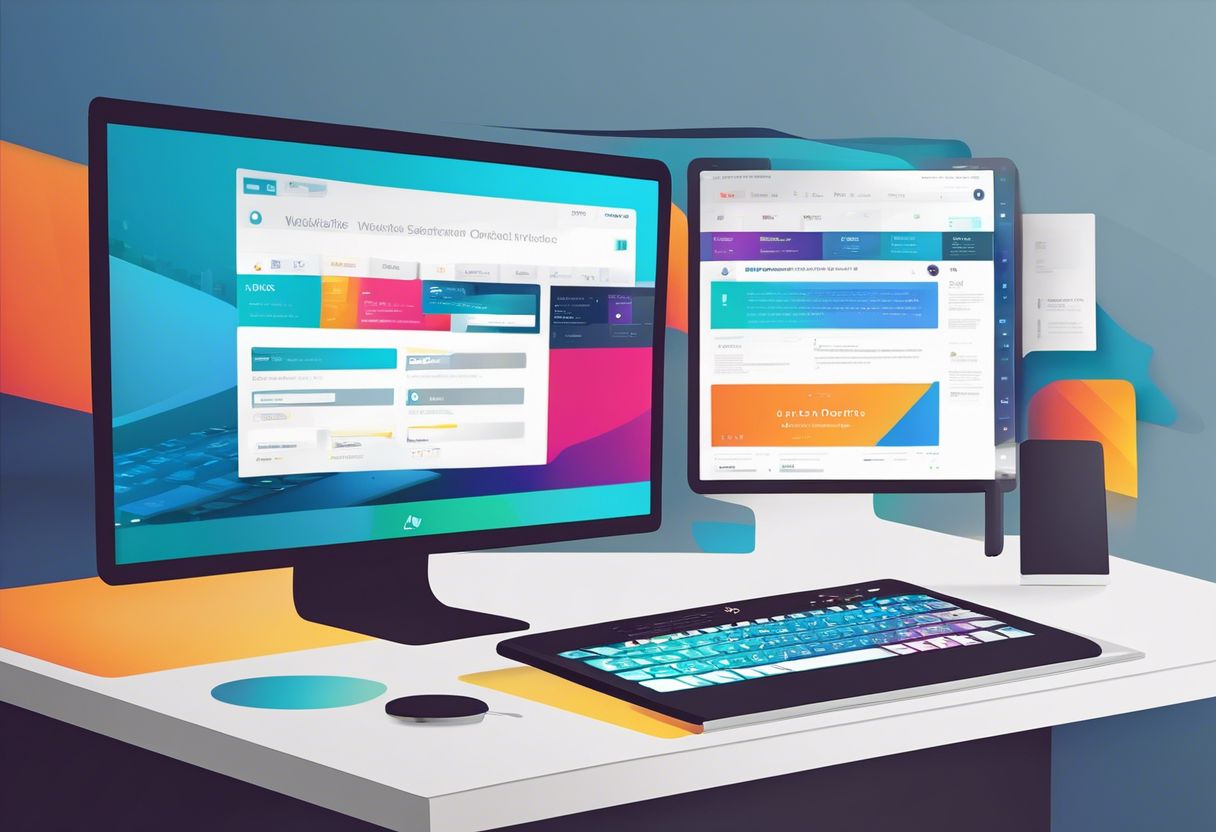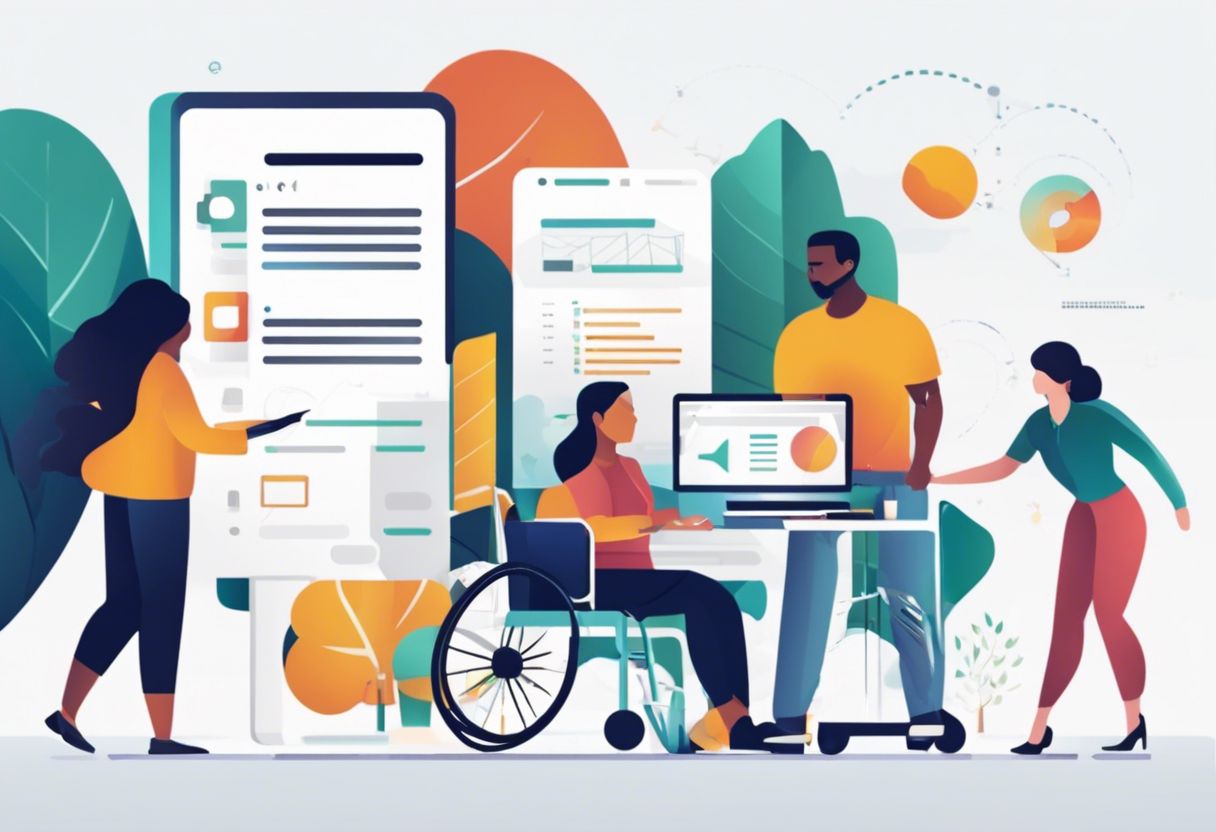Web Accessibility: Ensuring Inclusivity in Your Design
 Web accessibility means making sure websites work for everyone, including people with disabilities. The Web Content Accessibility Guidelines (WCAG) are rules that help us do this. We design web pages so all can use them well.
Web accessibility means making sure websites work for everyone, including people with disabilities. The Web Content Accessibility Guidelines (WCAG) are rules that help us do this. We design web pages so all can use them well.
This is important because we want everyone to have a good time online.
Sometimes, websites are hard for some people to use. They might not be able to see the screen or hear videos. We need to fix this because 90% of sites aren’t easy enough for everyone to use.
When we make our sites better, we follow seven rules – like keeping things simple and fair. Our sites must look good on phones, tablets, and computers of all sizes too.
Laws say our websites must be open to all people. If they’re not, there could be big problems.
We also want many different kinds of people to enjoy using our websites. To do that right, we check with users who are very different from each other.
Our story here will tell you how to include more people in your website’s design journey. Let’s start making the web welcoming for all!
Understanding Web Accessibility: Beyond Compliance

Understanding web accessibility goes beyond just meeting legal compliance. It involves creating a digital landscape that is inclusive, usable, and accessible to all individuals, regardless of disabilities.
The impact of inaccessible web design can hinder user experience and limit opportunities for equal access to information and services.
Definitions: Accessibility, Usability, and Inclusion

We see accessibility as the key to opening doors for everyone on the web, no matter their abilities or situations. It’s all about making sure that our websites and digital tools work well for people with disabilities or those in challenging environments.
Think of it like building a ramp alongside stairs – we’re ensuring that there is always a way for everyone to join in.
Usability steps up the game by focusing not just on access but also on how easy and pleasant these digital spaces are to use. A site that’s usable gets out of your way; it helps you do what you want quickly and without confusion.
We aim for our sites to feel like helpful friends, guiding users smoothly from point A to point B.
Inclusion wraps everything together, taking it beyond just following rules. We design with human-centered attention, celebrating diversity and making sure every voice can be heard through technology.
This means recognizing the full spectrum of users, embracing differences, and crafting experiences that welcome each unique visitor.
Let’s make sure our web designs speak directly to this blend of accessibility, usability, and inclusion so they can touch more lives positively. With these definitions clear in our minds, let’s dive into understanding why some websites fall short in providing equal access – and how we can change that narrative going forward.
The Impact of Inaccessible Web Design

Having a clear understanding of accessibility, usability, and inclusion sets the stage for us to tackle the real-world challenges an inaccessible website presents. Websites that are hard to use can turn away lots of people.
This includes folks with disabilities who might find it tough to interact with your site if it’s not designed with them in mind. And this isn’t just about being nice—it can also hurt your business.
Let’s consider how missing out on accessible design affects us all. If our websites don’t welcome everyone, we lose potential customers right from the start. That means less money and fewer people knowing about what we offer.
We also risk getting into legal trouble because there are laws that say our sites need to be accessible to everybody.
Inaccessible web design shuts doors on huge numbers of users eager for our services or products, cutting down on user experience and engagement across different devices and platforms.
This lack of access doesn’t only leave a bad taste; it could lead to negative word-of-mouth, damaging our reputation among customers who value inclusivity or have friends who do.
Our goal is always expanding reach to a wider audience by making sure anyone can easily get information from our site no matter their ability. And let’s face it—doing good here does good for our business too!
Principles of Inclusive Web Design

Understanding the core principles of inclusive web design is essential for creating an accessible and user-friendly digital experience. By incorporating these principles into your design process, you can ensure that your website is welcoming and usable for all users, regardless of their abilities or disabilities.
From clear navigation to providing alternative text for images, there are practical tips to implement accessible features that prioritize inclusivity in your web projects.
Seven Core Principles to Guide Your Design

We know creating a website that everyone can use is important. Let’s follow seven core principles to make our websites welcoming and easy for all.
- Flexibility: Our designs should work for everyone, no matter how they access the web. This means our websites must work well on different devices, like phones, tablets, and computers.
- Simplicity: We aim for clear and simple designs. Users shouldn’t get lost or confused. We use plain language and straightforward paths so users can find what they need fast.
- Consistency: Keep things familiar across our site. This helps users know where to find things because it’s like other sites they’ve been to.
- Perception: Make sure people can see or hear our content. Use big text and high contrast colors so it’s easier to read. Also, add text descriptions for images so people who can’t see them still know what’s there.
- Equity: Treat every user fairly with our design choices. Provide the same information and tools to everyone, making sure no one is left out.
- Prevention: Stop mistakes before they happen by designing thoughtfully. If a user enters something wrong, we gently guide them back without frustration.
- Accommodation: Think about all kinds of users when we create our site – including those with physical or mental challenges – and build features that help them too.
Practical Tips for Implementing Accessible Features

Ensuring your website is accessible is crucial. Here are practical tips to help you implement accessible features:
- Use a readable font to improve accessibility for all users, especially those with visual impairments.
- Provide alternative text for images so that screen readers can describe them to visually impaired users.
- Ensure touch screen accessibility by making sure that all interactive elements can be easily accessed and used on touch screens.
- Implement keyboard navigation to enable users who cannot use a mouse to navigate your site using only the keyboard.
- Pay attention to color contrast to make sure text is easily readable for people with color vision deficiencies.
- Include video captions to make your videos accessible to those who are deaf or hard of hearing.
- Provide text transcripts for audio content, ensuring it’s accessible to all, including those using screen readers.
- Use ARIA landmarks to help screen reader users navigate the different sections of your website efficiently.
- Use focus indicators on interactive elements so that keyboard and screen reader users can understand where they are on a page.
- Ensure your forms are accessible, providing clear instructions and error messages for all users, including those who rely on assistive technologies.
Responsive Web Design Techniques for Accessibility Across Every Screen

Responsive web design adapts and scales smoothly across different devices and screen sizes. Here are some essential techniques to ensure accessibility across every screen:
- Employ flexible web layouts that adjust seamlessly to various screen dimensions.
- Utilize inclusive web design principles to ensure usability for individuals with diverse abilities.
- Optimize for navigable websites that can be easily accessed by people using assistive technologies.
- Ensure that your website is usable by individuals with disabilities, including those using screen readers.
- Test and iterate the design to guarantee an optimal viewing experience on all devices and screen sizes.
- Create an all – encompassing user experience that caters to a broad range of users, considering different abilities and needs.
Legal Landscape and Compliance

Understanding the legal landscape and compliance requirements for web accessibility is crucial for small business owners. From ADA requirements to potential legal ramifications of inaccessible websites, it’s important to stay informed and ensure your design meets the necessary standards.
Keep reading to learn more about how to navigate this aspect of web accessibility in your small business.
Overview of ADA Requirements for Websites

To ensure that your website is inclusive and accessible to everyone, including those with disabilities, it’s crucial to understand the ADA requirements. The Americans with Disabilities Act (ADA) requires websites to be accessible to people with visual, auditory, motor, and cognitive impairments.
This means ensuring that all individuals have equal access to goods and services on your website. Compliance with ADA standards not only fulfills legal obligations but also creates a more welcoming online environment for all users.
Employing tools like website ADA compliance checkers can help you guarantee that your digital services align with these accessibility guidelines.
Common Accessibility Issues and Legal Ramifications

As small business owners, we recognize the necessity of creating websites that are accessible to all users, including those with disabilities. Recognizing common accessibility issues is the first step toward avoiding potential legal ramifications. The Web Content Accessibility Guidelines (WCAG) are our roadmap to compliance and inclusivity.
| Common Accessibility Issue | Description | Potential Legal Ramification |
|---|---|---|
| Non-Text Content | Lack of alt text on images and videos which makes content inaccessible for visually impaired users. | May result in non-compliance with ADA and WCAG, leading to legal action. |
| Poor Color Contrast | Insufficient contrast between text and background colors, hindering readability for users with visual impairments. | Potential lawsuits for not adhering to WCAG 2.1 AA standards. |
| Keyboard Inaccessibility | Website functions are not navigable using a keyboard, impacting users with motor disabilities. | Legal challenges citing exclusion of a significant user base. |
| Missing Document Structure | Headings, lists, and other structural elements are not properly defined, confusing screen reader software. | Risk of litigation for failing to provide accessible digital content. |
| Time-Based Media | Content that is time-based, like videos without captions or transcripts, excludes deaf or hard of hearing users. | Possible legal complaints under ADA Title III. |
| Mobile Inaccessibility | Content is not optimized for mobile use, creating barriers for users with disabilities accessing the site on mobile devices. | Increase in legal actions as mobile accessibility becomes a focus of ADA compliance. |
| Complex Navigation | Difficult and confusing navigation setups that frustrate users with cognitive disabilities. | Higher risk of facing ADA-related lawsuits due to poor user experience. |
By addressing these common issues, we not only work towards fulfilling our legal obligations but also extend our market reach and enhance the user experience for everyone. Let’s move forward, keeping all users in mind as we discuss designing for diversity and creating an inclusive user experience.
Designing for Diversity: Creating an Inclusive User Experience

To create an inclusive user experience, it is essential to develop web personas that represent a diverse range of users. This involves understanding the unique needs and challenges faced by individuals with disabilities or different backgrounds, and then testing and iterating your design to ensure that it caters to a wide array of users.
Strategies for Developing Accessible Web Personas

When developing your web personas, consider the diverse needs of all potential users. Embrace user diversity factors to ensure inclusive design. Here are practical strategies to develop accessible web personas:
- Incorporate a range of abilities and disabilities in your personas, considering users with visual, auditory, motor, and cognitive impairments. Enhance disability-inclusive design by addressing diverse user accessibility needs.
- Design personas that encompass different demographic profiles, including various ages, languages, cultural backgrounds, and technological competencies. Embrace designing for diversity by reflecting the broad spectrum of potential users.
- Ensure that your web personas represent a wide range of user preferences and assistive technologies to create an inclusive user interface. Keep diverse user experience at the forefront of persona development.
- Integrate considerations for accessibility throughout the entire UX design process when crafting web personas. Make inclusive UX design a priority from the early stages of persona creation.
- Test and iterate your web personas to validate their inclusivity and usability across diverse user groups. Use motivational language to encourage readers to strive for continuous improvement in creating more accessible web personas.
How to Test and Iterate for Greater Inclusivity

After considering strategies for developing accessible web personas, it’s important to explore how to test and iterate for greater inclusivity. Here are essential steps to ensure your design is inclusive:
- Conduct usability testing with diverse user groups including those with different abilities and backgrounds.
- Gather feedback from users through surveys and interviews, focusing on accessibility and inclusivity.
- Use the feedback to make iterative design improvements that cater to a wider range of users.
- Create user scenarios that represent diverse abilities and backgrounds to test the inclusivity of your design.
- Implement accessibility testing tools to evaluate the usability of your website or application for users with disabilities.
- Ensure that your design allows navigation using assistive technologies such as screen readers and voice commands.
- Continuously engage in user testing and iteration to refine and improve the inclusivity of your design.
Conclusion

In conclusion, web accessibility is vital for creating inclusive and compliant websites. Prioritizing accessibility ensures that everyone, including those with disabilities, can access and interact effectively with online content.
By embracing inclusive web design principles and implementing accessible features, small business owners can develop user-friendly experiences for a diverse audience. Ultimately, prioritizing web accessibility not only fosters inclusivity but also enhances the overall quality of web projects.
Discover more about crafting adaptable online spaces by exploring our detailed guide on responsive web design techniques for every screen.
FAQs
1. Why is web accessibility important?
Web accessibility is essential to ensure that people with disabilities can perceive, understand, navigate, and interact with the web, thus providing equal access to information and services.
2. What are some common barriers to web accessibility?
Common barriers to web accessibility include lack of alternative text for images, poor color contrast, inaccessible forms or controls, and complex navigation structures.
3. How can I make my website more accessible?
You can enhance your website’s accessibility by using descriptive alt text for images, ensuring sufficient color contrast, organizing content with clear headings and labels, and providing keyboard navigation options.
4. What are the benefits of designing an inclusive website?
An inclusive website allows a broader audience to access your content, improves user experience for everyone, enhances search engine optimization (SEO), and demonstrates social responsibility.
5. Are there legal requirements for web accessibility?
Yes, several countries have laws mandating websites to be accessible. For instance in the US., Section 508 of the Rehabilitation Act requires federal agencies’ electronic and information technology to be accessible to people with disabilities.


